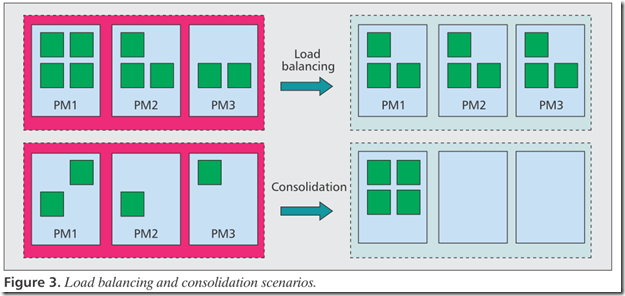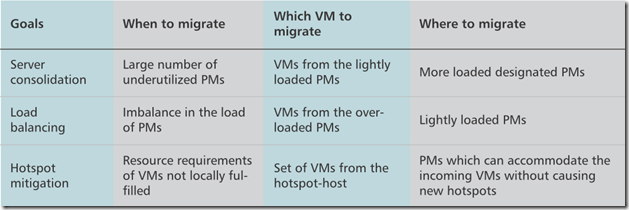Timespan: 1.29 – 1.30
Mayank Mishra, Anwesha Das, Purushottam Kulkarni, Anirudha Sahoo: Dynamic resource management using virtual machine migrations. IEEE Communications Magazine 50(9): 34-40 (2012) (gs:0)
作者Mayank Mishra于2006年从印度理工学院(IIT)获得硕士学位,之后在思科工作了几年,目前在印度理工学院读博。
这篇是发表在IEEE Communications杂志上的文章,对VM迁移的动机进行了分类,并着重讨论综述了三个问题:迁移时机、迁移对象、迁移目的,此外还比较了Internet环境下与LAN环境下VM迁移的不同点。以下是摘录:
1. 虚拟机迁移的三种方式:suspend-and-copy, pre-copy, post-copy
2. 迁移的目标一般都是为了在满足SLA条件下使资源耗费最小,迁移动机可以分为以下三类:
- server consolidation
- load balancing
- hotspot mitigation
迁移的两种场景 -- load balancing和consolidation(合并)的示意图
3. 迁移时机(When to migrate)
- periodic:定期迁移
- due to hot spot:热点检测可以分为proactive(主动检测,通过分析VM资源利用的趋势来预测热点以避免发生)和reactive(被动)两种
- excess spare capacity
- load imbalance
- addition/removal of VMs and PMs
4. 迁移对象(Which VM to migrate)
- resource constrained VM
- holistic(全局的) approach:从全局的角度选择迁移的对象,使得迁移的代价较小
- affinity based:比如两个VM通讯非常频繁,那么最好不要把其中一台迁移走
5. 迁移目的(Where to migrate)
- depending on available resource capacity
- depending on affinity of VMs:比如memory-aware migration
6. 下面是各种迁移目标及对应的策略关系表
7. Internet环境中与LAN环境中迁移的区别
- migrating storage:WAN需要传输local disk的数据
- network reconfiguration:IP地址会变
为什么需要WAN migration?
原因:比如大型数据中心或企业拥有多个数据中心(可能分布于多个时区),每天需要定时将一些VM迁移到离用户更“近”的位置。另外维护和升级也需要用到WAN migration。
8. 文中提到的一些文献
* 从全局角度选择迁移对象时,目标函数的设计[3-5]
* 不同VM之间的memory share[6]
* gang migration[7]
* 选择合适的迁移目的使得资源耗费最小化[5]
[3] T. Wood et al., “Black-Box and Gray-Box Strategies for Virtual Machine Migration,” Proc. 4th Conf. Symp. Networked Sys. Design & Implementation, 2007.
[4] A. Singh et al., “Server-Storage Virtualization: Integration and Load Balancing in Data centers,” Proc. 2008 ACM/IEEE Conf. Supercomputing, IEEE Press, 2008, pp.1–12.
[5] M. Mishra and A. Sahoo, “On Theory of VM Placement: Anomalies in Existing Methodologies and Their Mitigation Using a Novel Vector Based Approach,” Proc. 4th Int’l. Conf. Cloud Computing, 2011, pp. 275–82.
[6] T. Wood et al., “Memory Buddies: Exploiting Page Sharing for Smart Colocation in Virtualized Data Centers,”Proc. ACM SIGPLAN/SIGOPS Int’l. Conf. Virtual Execution Environments, VEE, 2009, pp. 31–40.
[7] U. Deshpande, X. Wang, and K. Gopalan, “Live Gang Migration of Virtual Machines,” High-Performance Parallel and Distributed Computing, June 2011.

